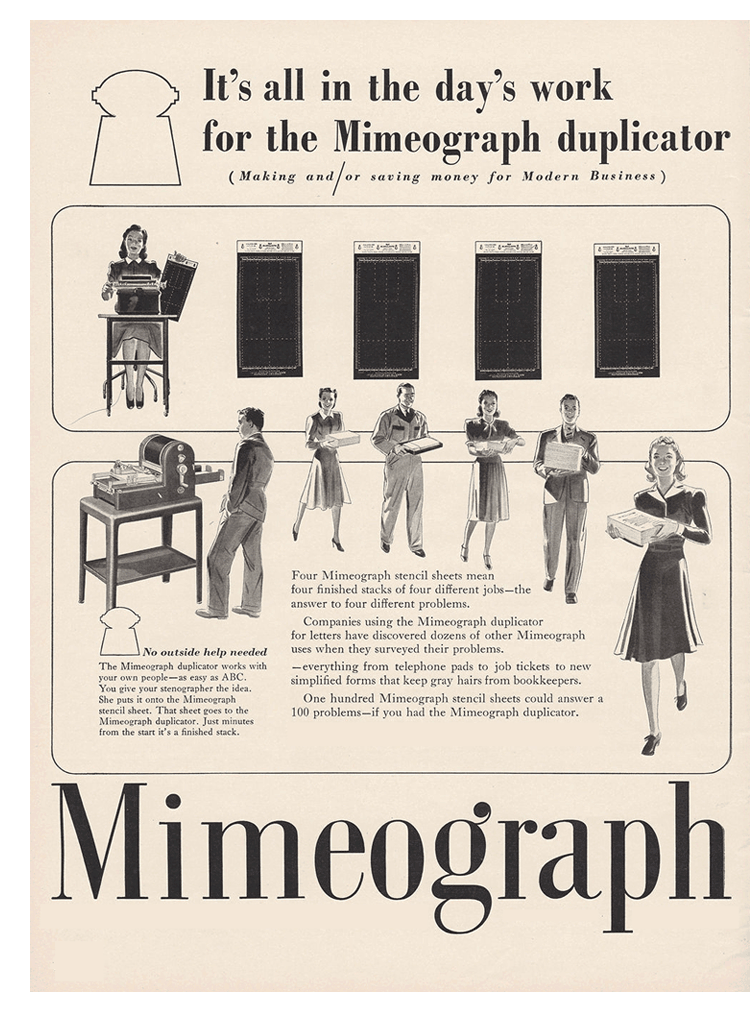PRE-COPIER COPIERS
The desire to duplicate information has been around just as long as there was information to share. Before written communication took hold, we can assume that information was shared verbally. Once writing became the mainstay of information collection, transcribing by hand was the only way to duplicate information. Then, of course, Martin Luther showed us the power of the printing press and changed the world.
Technology, of course, has made great strides since then. But before Chester Carlson and the folks at Xerox brought the modern copier to offices everywhere, how were documents copied?
 Easing the process of information duplication has long been on the minds of inventors, and over the years they have developed numerous methods and technologies. Here are a few of the better known and most effective pre-copier copiers:
Easing the process of information duplication has long been on the minds of inventors, and over the years they have developed numerous methods and technologies. Here are a few of the better known and most effective pre-copier copiers:
Pantograph: Thomas Jefferson was perhaps the most famous endorser (and user) of the pantograph. The relatively simple wooden devise, invented by Christoph Scheiner around 1600, connects two writing devices by a series of conjoined wooden rods. The rods allow the second writing devices to mimic the movements of the first.
James Watt’s Copier: Inventor James Watt was one of the first to experiment with methods of physically transferring ink from one document onto another. The blank document, which had been moistened with a solvent, was pressed with great force into the original. After much experimentation, Watt was able to devise the correct ink and paper combination to make his process patent-worthy. The process was improved and used into the early 20th century.
Hectograph: The hectograph, which was introduced in 1876, took Watt’s ink-transferring idea to the next level. A master document was laid on top of a cake pan full of firm gelatin. After the ink soaked had into the gelatin, blank sheets of paper would be laid on top of the gelatin to transfer the image. As you might expect, the copies were less than perfect, and the transfer process only lasted for a few copies before it needed to be refreshed.
Mimeographs: The mimeograph, invented by Albert Blake Dick in 1884, is the pre-copier copier that some people today are still familiar with. The devices used waxed-paper sheets could cut through and create a stencil. The stencil was wrapped around the drum of the machine, and ink was forced out through the cut marks on the stencil and onto a blank sheet. The mimeograph allowed for cleaner, more exacting copies to be produced at a much higher volume. The drawback, of course, was that copies were limited to a single color.
Spirit Duplicator: Better known as a “ditto machine”, spirit duplicators improved upon the mimeograph and allowed the use of multiple colors. Spirit duplicators used a two-ply paper that allowed the top sheet to be typed, drawn, or written on. The second sheet was coated with a layer of colored wax. The pressure on the top sheet from drawing or typing, forced the colored wax from the second sheet to adhere to its backside. The wax sheet would then be discarded, and the and top sheet, containing the images, was attached to the drum of the machine, with the image side out. It would then be pressed against a blank sheet and the image would transfer. Because it was able to transfer multiple colors, the spirit duplicator was popular with cartoonists.
Mimeographs and spirit duplicators were the office norms until Chester Carlson invented electrophotography in the mid-1930s. Electrophotography, also known as xerography, is the process that most copiers use, even today.
Return to the Tech Trends Newsletter

